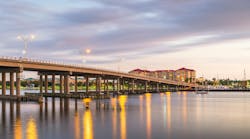Since the 1930s, South Bend, Wash., had stored its main water supply in a recessed open reservoir impoundment. The 5-million-gal reservoir was created by constructing a dam across a ravine and included a soil and cement liner along with a floating cover.
By 2006, 70-plus years of wear on the reservoir had taken its toll, resulting in both economic and potential health issues. The numerous leaks in the liner allowed treated water to seep away, resulting in lost revenue and potential contamination. The cover was dilapidated and allowed untreated water to enter the reservoir, posing health risks from contamination. In addition, the 5-million-gal capacity was more than the city needed. A large volume of water often sat stagnant during lower use periods.
To address their deteriorating reservoir and concerns from the Washington State Department of Health, the city of South Bend hired Gray and Osborne Inc., a consulting engineer firm serving Washington, in 2006 to evaluate and develop a solution for their future potable water needs. Dominic Miller, P.E., served as the firm’s project manager for the Main Reservoir Replacement Project. According to Miller, an initial study deemed repair of the reservoir and replacement of the cover to be costly, while not fully addressing the issues with the reservoir. It also concluded that the city did not need 5 million gal in storage volume.
“We determined that the optimal configuration was to go with two aboveground tanks within the footprint of the old reservoir,” Miller said. “This would minimize earthwork and site preparation and also maximize the storage volume. The final specification required two tank sizes with a total storage capacity of 2.1 million gal to accommodate the reservoir’s triangular shape and also to ensure freshwater flow containing adequate chlorine.”
Life cycle cost analysis played a key factor in evaluating tank options for the city, according to Miller. “Glass-coated steel tanks feature a coating that requires much less maintenance, which is an economic benefit over time,” Miller said. Aquastore glass-fused-to-steel tanks were selected and later constructed on-site by Aquastore NW of Canby, Ore. The tanks have a capacity of 1.42 million gal and 690,000 gal, respectively.
Construction for the Main Reservoir Replacement Project took five months from the time of the signed contract to its finish. The tanks took two months to construct following site preparation. The system was fully back online in fall 2008.
“South Bend has three seafood processing plants whose peak processing and water demand period have historically occurred in late Fall,” Miller said. “While their water volume demands were not as high as usual, the project was finished on time to meet their potential needs.”
Miller added that a third Aquastore tank (350,000 gal capacity) was built in 2007 at another site to also accommodate the city’s water needs and balance water storage. This served as the city’s water storage while the old Main Reservoir was offline.
Overall, the city of South Bend is satisfied with the new potable water storage system, Miller said. The Aquastore tanks have been maintenance free since construction, and the city recognizes that the Aquastore glass-coated steel tanks are not anticipated to require recoating or repainting over the life of the structures. “It was a difficult site with a bit of a tight construction timeline,” Miller added. “But we were able to successfully implement an effective solution to address South Bend’s water storage needs.”
Source: Engineered Storage Products Co.


